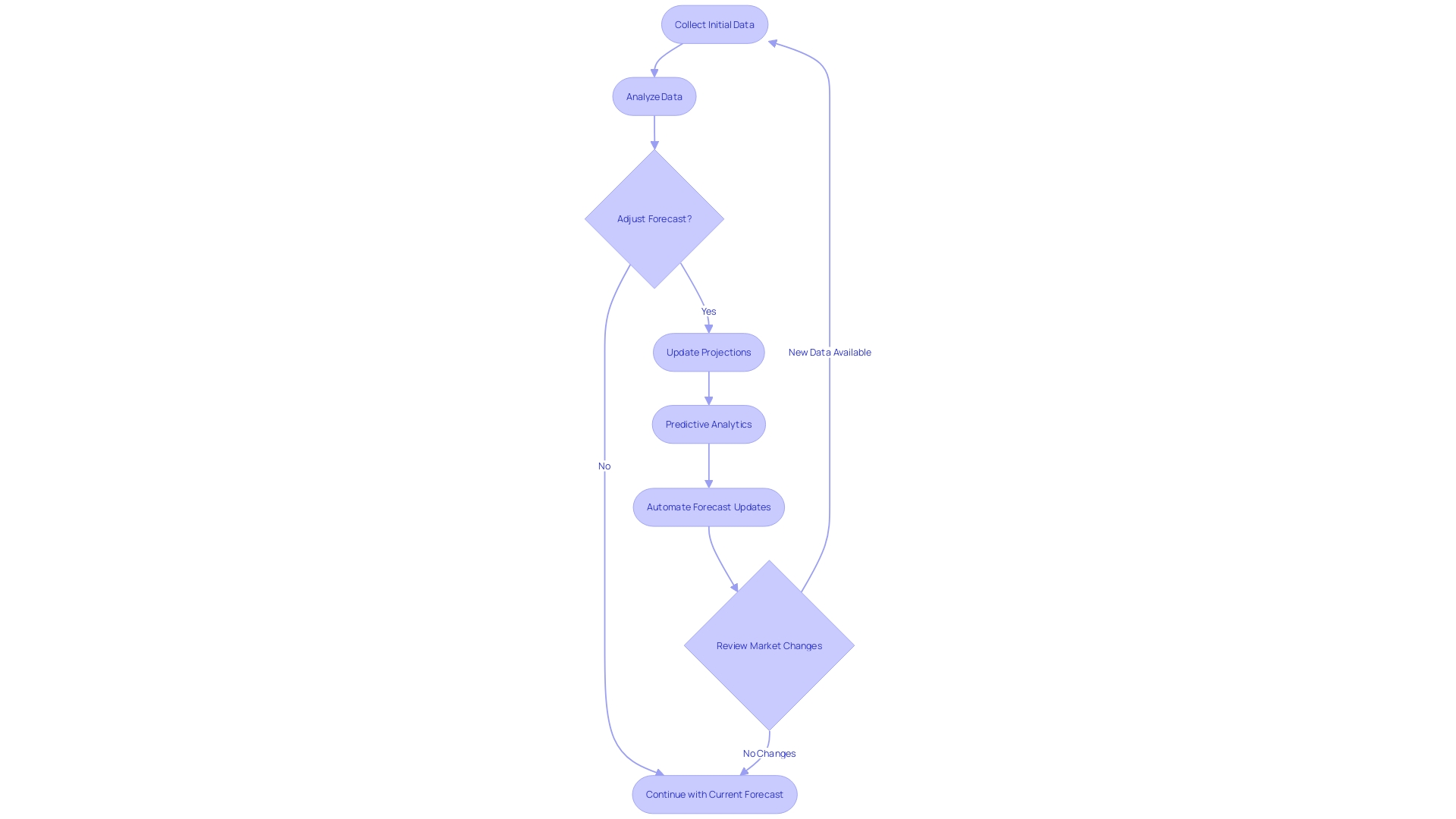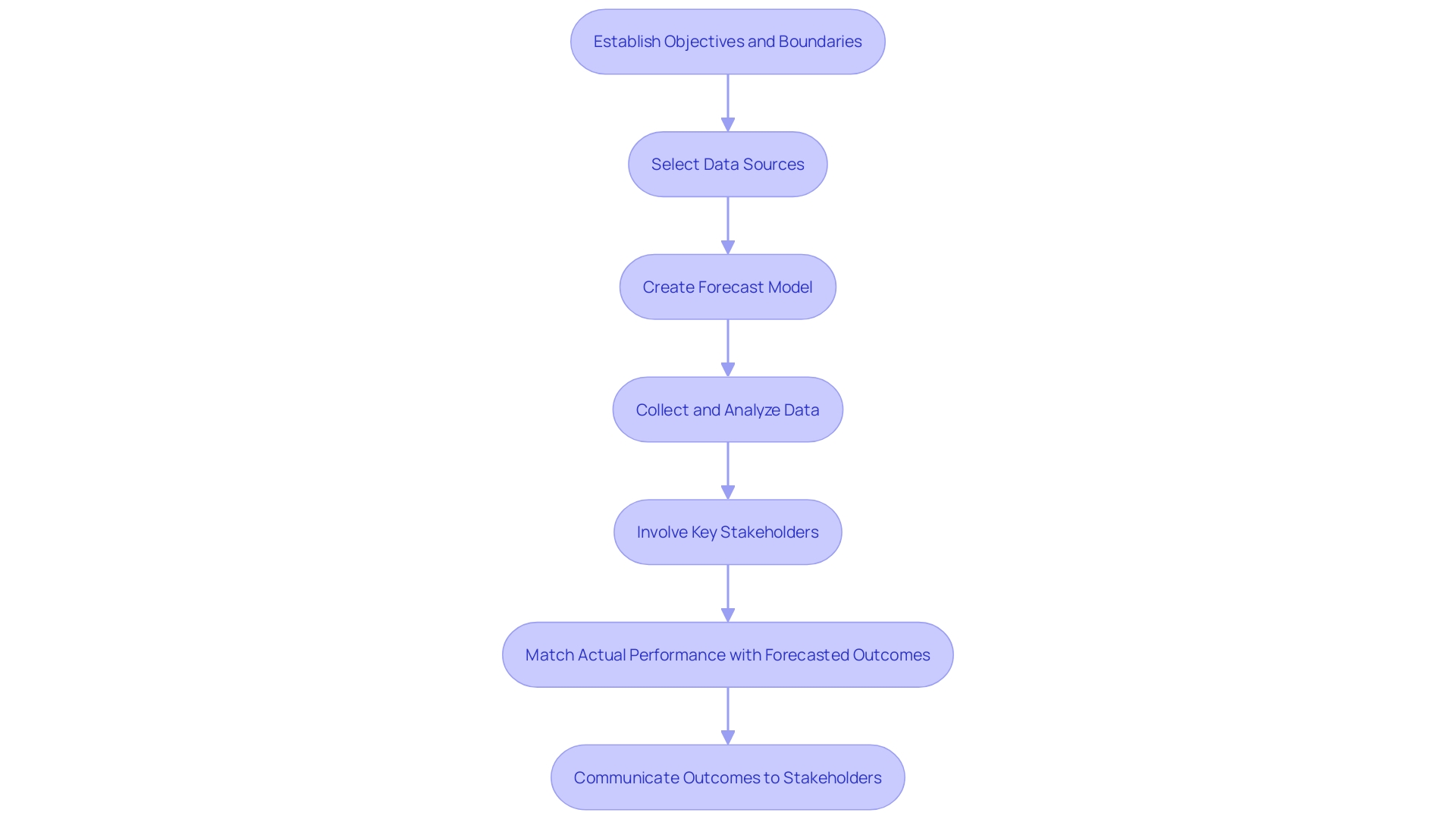Introduction
Rolling forecast budgeting has emerged as a vital process in the financial toolkit, allowing businesses to project future financial performance with flexibility and agility. Unlike traditional budgeting methods, which rely on static, annual planning cycles, rolling forecasts provide a dynamic approach to financial management. By continuously updating projections, organizations can adapt their strategies in real time, responding to market changes and capitalizing on opportunities.
This article explores the key differences between rolling forecast budgeting and traditional budgeting, the benefits it offers, and the necessary steps to implement it effectively. By embracing rolling forecasts, businesses can navigate the complexities of modern financial management and position themselves for success in today's rapidly changing business environments.
What is Rolling Forecast Budgeting?
Rolling forecasts represent a strategic tool in the financial toolkit, allowing businesses to project future financial performance with a flexibility that traditional budgeting does not afford. By continuously updating projections, organizations can respond to market changes with agility, much like a driver adjusting the course based on the road ahead rather than a predetermined path. This modern approach to financial management aligns with the dynamic nature of today's business environments, where adaptability can be a significant competitive advantage.
For example, predictive analytics has revolutionized the way businesses anticipate future trends and market demands. By harnessing the power of artificial intelligence and machine learning, companies can analyze vast amounts of data to make informed predictions, much more rapidly and accurately than traditional forecasting methods. This real-time information feeds into the rolling forecast, enabling a proactive rather than reactive financial strategy.
The effectiveness of rolling forecasts is further evidenced in various industry practices. The hospitality industry, for example, has seen a shift towards Zero-Based Budgeting, which, like rolling forecasts, demands a fresh perspective each year, challenging the status quo of resource allocation and emphasizing efficiency and strategic planning. Such practices underscore the importance of agility and the need for tools that support dynamic decision-making.
Moreover, in the context of IT budgeting, the move towards automation has shown the potential to significantly optimize budgets. Automating routine tasks not only saves money but also allows for reallocating resources to more strategic initiatives, which can be better forecasted and managed through rolling forecasting techniques.
Industry experts, like Jurgen Appelo and Michael Grove, emphasize the obsolescence of yearly budgets and the critical role of data in budget planning. Real-time access to performance data and market analysis facilitates a more accurate and effective budgeting process, underscoring the need for a shift towards practices like rolling forecasting.
In conclusion, as financial landscapes evolve and the need for swift adaptation becomes more pronounced, rolling forecast budgeting emerges as a vital process. It allows organizations to navigate the complexities of modern financial management and positions them to capitalize on opportunities while mitigating risks.

How Does Rolling Forecast Budgeting Differ from Traditional Budgeting?
Unlike traditional budgeting methods, which are often characterized by annual, static planning cycles, rolling forecasts usher in a dynamic approach to financial management. Traditional budgets hinge on assumptions that remain unchanged for the entire period, potentially leading to discrepancies between the budget and actual performance due to market volatility. In contrast, rolling forecasts are continuously updated, usually on a quarterly or monthly basis. This frequent revision allows companies to adapt their financial strategies in real time, reflecting current market trends and new business information.
Rolling forecasts also diverge from conventional budgeting by employing a fluid, extendable time horizon. While traditional budgets fixate on a set period, rolling forecasts look ahead, typically over a span of 12 to 18 months, and this horizon moves forward with each review cycle. By doing so, organizations gain the foresight to navigate future financial landscapes with greater precision and adaptability.
At the core, the rolling forecast model is built on dynamic assumptions that evolve with new data, enabling more accurate and actionable insights. This forward-looking approach provides a strategic advantage in resource allocation and decision-making, allowing companies to be proactive rather than reactive in their financial planning. The agility afforded by rolling forecasts is particularly valuable in rapidly changing industries, where traditional budgeting can often hinder responsiveness and growth.

Benefits of Rolling Forecast Budgeting
Rolling forecasts serve as a dynamic financial planning tool, enabling organizations to maintain agility and respond swiftly to market shifts. By continuously refreshing their projections, businesses can promptly detect risks and opportunities, leading to more strategic decision-making. This contrasts traditional annual budgets that often become outdated quickly, particularly in volatile environments. For example, zero-based budgeting (ZBB) starts from a clean slate each year, compelling departments to justify every expense, thus fostering fiscal responsibility and cost reduction. Similarly, rolling forecasts avoid relying on historical data alone and instead incorporate current information to enhance the accuracy of financial predictions.
Moreover, rolling forecasts are instrumental in bridging communication gaps among stakeholders. By providing a clear and updated view of financial objectives and necessary actions, it cultivates a collaborative atmosphere. This is crucial in industries like hospitality, where departments must align closely to effectively manage resources. As Jurgen Appelo highlights, 'Yearly budgets are an archaic idea. Business environments change too fast to work with an annual budgeting cycle.' This reinforces the notion that static budgets are insufficient in today's fast-paced business world.
Lastly, adopting a rolling forecast approach ingrains a culture of continuous improvement. Organizations are encouraged to routinely evaluate and refine their financial strategies based on real performance data and market feedback. This ongoing process not only helps in making informed investment decisions but also supports sustainable growth. As businesses explore how to best allocate funds, they must consider the potential return on investment and the impact of their financial choices, ensuring that every dollar is put to its best use.

Key Steps to Implementing Rolling Forecast Budgeting
To effectively implement rolling forecast budgeting, organizations must meticulously plan and execute a series of strategic steps. Firstly, it is crucial to establish the primary objectives and boundaries of the rolling forecast, ensuring they are in harmony with the organization's overarching strategic targets. Selecting the right data sources, which could range from historical financial records to current market trends and internal performance metrics, forms the bedrock of a reliable rolling forecast.
Creating a robust rolling forecast model is the next step, which should encompass defining the time horizon, the frequency at which updates will be made, and the key assumptions that will be integrated. With the model in place, the focus shifts to the meticulous collection and analysis of pertinent data to shape the rolling forecast, prioritizing accuracy and thoroughness.
An inclusive approach that involves key stakeholders, such as department heads and finance teams, is vital. Their insights are essential to validate the assumptions underpinning the rolling forecast. As the forecast takes shape, it is imperative to continuously match actual performance with forecasted outcomes, making real-time adjustments to the forecast as necessary.
Lastly, the process culminates with the clear communication of the rolling forecast outcomes to all stakeholders. This dissemination of information should underscore crucial insights and actionable recommendations. Adhering to these steps can lead organizations to not only implement rolling forecast budgeting successfully but also harness its full potential to drive strategic financial decisions.

Conclusion
Rolling forecast budgeting offers businesses the flexibility and agility to project future financial performance. Unlike traditional budgeting, rolling forecasts continuously update projections, allowing organizations to adapt in real time and capitalize on opportunities. With a dynamic approach to financial management, companies can navigate market changes and position themselves for success.
The key differences between rolling forecast budgeting and traditional budgeting lie in the continuous updates and extendable time horizon of rolling forecasts. Traditional budgets rely on static, annual planning cycles, while rolling forecasts are frequently revised, typically on a quarterly or monthly basis. This adaptability enables companies to adjust their financial strategies based on current market trends and new business information.
The extendable time horizon of rolling forecasts provides a forward-looking perspective, helping organizations navigate future financial landscapes with precision and adaptability.
Rolling forecast budgeting brings significant benefits. It serves as a dynamic financial planning tool, allowing businesses to respond swiftly to market shifts and make strategic decisions. By continuously refreshing projections, organizations can identify risks and opportunities in a timely manner.
Rolling forecasts also foster communication and collaboration among stakeholders, providing a clear view of financial objectives and necessary actions. This promotes effective resource management and supports growth.
To implement rolling forecast budgeting effectively, organizations should follow key steps. They need to establish primary objectives and boundaries that align with strategic targets. Selecting appropriate data sources and creating a robust rolling forecast model are crucial.
Meticulous data collection and analysis ensure accuracy and thoroughness. Involving key stakeholders helps validate assumptions, and continuous monitoring allows for real-time adjustments. Clear communication of rolling forecast outcomes to all stakeholders ensures understanding and facilitates informed decision-making.
By embracing rolling forecasts, businesses can navigate the complexities of modern financial management and stay ahead in rapidly changing environments. Rolling forecast budgeting empowers organizations to proactively manage their finances, make informed decisions, and adapt to market dynamics. Though implementing rolling forecast budgeting requires strategic planning and collaboration, the benefits far outweigh the effort.




